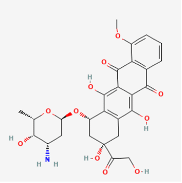Doxorubicin is a chemotherapeutic drug that is commonly known as the “Red Devil”.
What is Doxorubicin?
Doxorubicin is a drug used during the course of chemotherapy in conjunction with other chemotherapeutic drugs. It belongs to a class of drugs known as anthracyclines. The main function of this drug is to inhibit the growth and proliferation of cancer cells, thus stopping the process of metastasis.
This chemical compound comes under the World Health Organisation’s list of “Essential Medicines” and is sold in the market under the brand name “Adriamycin”. It works by interfering with DNA functioning.
It is used for the treatment of the following diseases
- Cancer of the thyroid gland, bladder, stomach, breast, lungs and ovaries.
- Multiple myeloma- WBCs become cancerous.
- Tissue sarcoma- soft tissue cells become cancerous.
- Leukaemia- Blood cells become cancerous.
- Hodgkin’s Lymphoma- Lymphocytes become cancerous and lymph nodes get blocked.
Chemical and Physical characteristics of Doxorubicin
- It is a red crystalline solid.
- It has a 2% solubility in water.
- It is soluble in aqueous alcohols.
- It is insoluble in non-polar organic solvents.
- It is odourless at room temperature.
- When heated, it emits toxic fumes of nitrogen oxide and hydrochloric acid.
The origin of the drug
The search for antitumor antibiotics began in the early 1950s. Around this time, an Italian research company called ‘Farmitialia Research Laboratories’ studied naturally occurring microbially-sourced antibiotics and discovered that a red-colored pigment secreted by the bacteria Streptomyces peucitius inhibited the growth of tumour cells in mice. At the same time, a similar discovery was made by a group of French scientists. Hence, the two groups decided to collaborate and the drug “Daunorubicin” was born.
Clinical trials began in the 1960s and it was concluded that this compound resulted in the risk of cardiac arrests hence different formulations of the drug were studied. Mutations induced in a species of Streptomyces using N-nitroso N-methyl urethane resulted in the production of a different red pigment with antitumor properties. This compound was christened “Doxorubicin”. Since Doxorubicin was also found to be cardiotoxic, different analogs of this compound have been used for the purpose of chemotherapy since the 1990s.
The Streptomyces bacteria
- These bacteria are Gram-positive and filamentous.
- They are aerobic in nature.
- They are popularly known for their ability to produce clinically essential antibiotic compounds.
- They are not frequently pathogenic but some species can induce infections in humans and plants.
- Recent biotechnological research has employed the use of Streptomyces bacteria as heterologous models for the production of desirable proteins, replacing the traditionally used Escherichia coli.
- The drug Streptomycin which is commonly used for the treatment of tuberculosis is derived from the culture of Streptomyces spp.
Mechanism of Action of Doxorubicin
Doxorubicin inhibits the growth and proliferation of cancer cells via the following steps:
- Doxorubicin intercalates with the DNA of tumour cells and interferes with the biosynthesis of macromolecules.
- This, in turn, inhibits the production of the enzyme ‘Topoisomerase II’ which is responsible for the relaxation of the supercoils of DNA. It is important to note that DNA transcription can only take place when the tightly coiled DNA is uncoiled.
- The cytotoxicity of Doxorubicin can also be attributed to its ability to increase the release of free radicals such as quinone.
- Crystal structure prediction has shown that the planar chromophore portion (which is aromatic in structure) intercalates the space between two DNA base pairs.
- The intercalation of DNA by Doxorubicin molecules induces the eviction of histone proteins in chromatin strands that are transcriptionally active thereby deregulating DNA damage repair mechanisms, transcriptomes and epigenomes.
Doxorubicin and its side effects
Even though Doxorubicin has proven to be a very clinically useful drug in the context of cancer treatment, it still causes a multitude of side effects which result in a lot of suffering for those taking this drug. This drug is usually introduced into the body intravenously through a cannula.
Common side effects include
- Increased risk of infections due to the inhibition of WBC growth.
- Paleness and tiredness due to the reduction of Red Blood Cells in the body. This condition is known as anaemia.
- Soreness and numb feeling of hands and feet accompanied by the peeling of the skin and a burning or tingling sensation.
- Bleeding of gums and increased risk of getting bruises due to the reduction of platelets in the body.
- Loss of appetite which is usually predeceased by an infection.
- Loss of all body hair. This hair usually grows back once the treatment is discontinued.
- As this drug is metabolised in the liver, there is also a chance of liver failure due to the hepatotoxicity of the compound.
- Changes in the functioning of heart muscles and rhythm.
Rare side effects include
- Inflammation of veins in the limbs.
- Breathlessness
- Chance of occurrence of secondary cancer.
- Life-threatening blood clots.
- Pericardial effusion is defined as the accumulation of fluid around the heart.
Conclusion
The discovery of the drug Doxorubicin helped medical researchers come a long way in the process of cancer treatment, however, there is still a long way to go as this drug does not completely guarantee the eradication of cancer cells in the body. It is also characterised by a number of side effects that can also prove to be fatal to the patient under consideration. Current studies are focusing on the use of Doxorubicin analogs that inhibit tumour cell growth without affecting healthy body cells.









